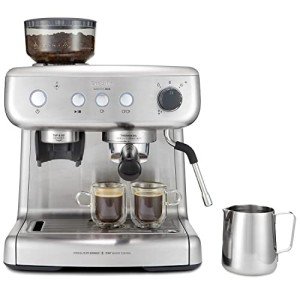Heat Exchange Espresso Machines: A Comprehensive Guide
Espresso machines have actually progressed significantly throughout the years, dealing with the requirements of home baristas and coffee specialists alike. Among these machines, heat exchange espresso machines have gained popularity due to their ability to provide constant efficiency and extraordinary brew quality. In this post, we will explore the functions, advantages, and important features of heat exchange espresso machines, providing a comprehensive understanding for both prospective purchasers and coffee enthusiasts.
Comprehending Heat Exchange Technology
Heat exchange espresso machines run on a special principle that permits synchronised water heating for brewing and steaming. They are geared up with a single boiler that uses a heat exchanger system. This feature is considerable as it makes it possible for users to brew espresso while steaming milk simultaneously, promoting performance in the coffee-making procedure.
How Does a Heat Exchange Espresso Machine Work?
The procedure begins with the machine's water inlet filling the boiler. As the water warms up, it turns to steam. Latte Machines uses hot steam to heat extra water in a different passage developed specifically for the brew group. This indicates that water can reach the perfect brewing temperature without awaiting the boiler to adjust. The key actions consist of:
- Water Fill: Water is drawn into the boiler.
- Heating Process: The boiler heats up as water is transformed into steam.
- Heat Exchange: Steam warms water in the heat exchanger tube.
- Developing: Water from the heat exchanger is pushed through coffee premises, drawing out the tastes needed for an abundant espresso.
This procedure permits quick temperature level modifications and improved coffee extraction.
Advantages of Heat Exchange Espresso Machines
Heat exchange espresso machines use several advantages, particularly for those wanting to optimize their coffee experience. Here are some crucial benefits:
- Simultaneous Brewing and Steaming: Users can brew espresso while steaming milk, making it ideal for busy coffee shops and home baristas who value performance.
- Temperature Stability: The boiler's steam pressure helps keep a steady temperature level, which is important for consistent espresso extraction.
- Flexibility: The design permits fast changing between brewing and steaming, making it simpler to develop various coffee beverages, from lattes to coffees.
- Easy to use: Models often come with available controls, making it feasible for both novices and knowledgeable baristas to produce quality beverages.
- Professional Quality: Heat exchange machines are frequently used in commercial settings, offering users with high-quality developing efficiency in the house.
Key Features to Look for in Heat Exchange Espresso Machines
When thinking about the purchase of a heat exchange espresso machine, there are numerous functions that one should take into account:
- Build Quality: Look for machines made of resilient products, such as stainless steel or brass, guaranteeing longevity.
- Boiler Size: A larger boiler will hold more water and sustain higher output gradually.
- PID Temperature Control: This feature helps keep constant brew temperature levels, which can enhance the coffee-making procedure.
- Group Head Design: Machines with a saturated or semi-saturated group head supply better temperature stability.
- Relieve of Use: User-friendly interfaces and user-friendly controls enhance the general experience for baristas at all ability levels.
- Steam Wand Quality: A good steam wand with appropriate insulation and versatility enables for better texturing of milk.
- Water Reservoir Size: Depending on your needs, consider how typically you desire to refill the water tank.
Contrast of Popular Heat Exchange Espresso Machines
To much better comprehend the choices readily available in the market, listed below is a contrast table of some popular heat exchange espresso machines:
| Machine Model | Boiler Size | PID Control | Rate Range | User Ratings |
|---|---|---|---|---|
| Profitec Pro 700 | 2.0 L | Yes | ₤ 2,000-₤ 2,500 | 9.5/ 10 |
| Rocket Espresso R58 | 1.8 L | Yes | ₤ 2,400-₤ 2,800 | 9.4/ 10 |
| Elekta Bianca | 1.8 L | Yes | ₤ 2,500-₤ 3,000 | 9.6/ 10 |
| La Spaziale S1 Vivaldi II | 1.5 L | Yes | ₤ 1,800-₤ 2,200 | 9.2/ 10 |
| Bezzera Magica | 1.2 L | No | ₤ 1,600-₤ 1,800 | 9.0/ 10 |
Frequently Asked Questions About Heat Exchange Espresso Machines
What is the primary distinction in between a heat exchange and a dual boiler espresso machine?
While both types can brew espresso and steam milk at the exact same time, dual boiler machines have separate boilers for developing and steaming. On the other hand, heat exchange machines use a single boiler and a heat exchanger to achieve the same function.
Are heat exchange machines appropriate for novices?
Yes! Numerous heat exchange machines are created with easy to use functions, making them available for novices. With proper assistance and practice, users can rapidly produce quality espresso.
What sort of upkeep do heat exchange espresso machines need?
Regular upkeep consists of descaling, cleaning up the boiler, examining seals and gaskets, and keeping the group head tidy. Routine upkeep guarantees durability and consistent performance.
Can I use a heat exchange machine for various types of coffee drinks?
Absolutely! Heat exchange machines permit users to produce a variety of coffee drinks, consisting of espresso, lattes, coffees, and more.
Heat exchange espresso machines represent a blend of development and custom, supplying coffee enthusiasts with the tools needed for crafting the ideal cup. Their ability to at the same time brew and steam, combined with exact temperature level control, makes them an engaging choice for both home baristas and experts. With the right understanding on functions and maintenance, users can open a world of exquisite coffee experiences, guaranteeing that each sip is as delightful as the last.

